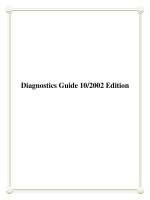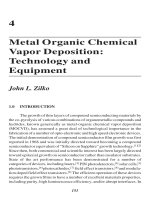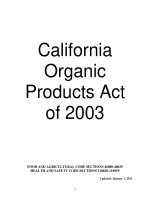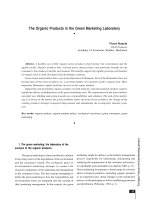Tài liệu Named Organic Reactions 2nd Edition pot
Bạn đang xem bản rút gọn của tài liệu. Xem và tải ngay bản đầy đủ của tài liệu tại đây (3.13 MB, 317 trang )
Named Organic
Reactions
2nd Edition
Thomas Laue and Andreas Plagens
Volkswagen AG, Wolfsburg, Germany
Translated into English by Dr. Claus Vogel
Leibniz-Institut f¨ur Polymerforschung Dresden, Germany
Copyright 2005 John Wiley & Sons Ltd, The Atrium, Southern Gate, Chichester,
West Sussex PO19 8SQ, England
Telephone (C44) 1243 779777
Email (for orders and customer service enquiries):
Visit our Home Page on www.wiley.com
All Rights Reserved. No part of this publication may be reproduced, stored in a retrieval system or transmitted
in any form or by any means, electronic, mechanical, photocopying, recording, scanning or otherwise, except
under the terms of the Copyright, Designs and Patents Act 1988 or under the terms o f a licence issued by the
Copyright Licensing Agency Ltd, 90 Tottenham Court Road, London W1T 4LP, UK, without the permission in
writing of the Publisher. Requests to the Publisher should be addressed to the Permissions Department, John
Wiley & Sons Ltd, The Atrium, Southern Gate, Chichester, West Sussex PO19 8SQ, England, or emailed to
, or faxed to (C44) 1243 770620.
Designations used by companies to distinguish their products are often claimed as trademarks. All brand names
and product names used in this book are trade names, service marks, trademarks or registered trademarks of their
respective owners. The Publisher is not associated with any product or vendor mentioned in this book.
This publication is designed to provide accurate and authoritative information in regard to the subject matter
covered. It is sold on the understanding that the Publisher is not engaged in rendering professional services. If
professional advice or other expert assistance is required, the services of a competent professional should be
sought.
Other Wiley Editorial Offices
John Wiley & Sons Inc., 111 River Street, Hoboken, NJ 07030, USA
Jossey-Bass, 989 Market Street, San Francisco, CA 94103-1741, USA
Wiley-VCH Verlag GmbH, Boschstr. 12, D-69469 Weinheim, Germany
John Wiley & Sons Australia Ltd, 33 Park Road, Milton, Queensland 4064, Australia
John Wiley & Sons (Asia) Pte Ltd, 2 Clementi Loop #02-01, Jin Xing Distripark, Singapore 129809
John Wiley & Sons Canada Ltd, 22 Worcester Road, Etobicoke, Ontario, Canada M9W 1L1
W iley also publishes its books in a variety of electronic formats. Some content that appears
in print may not be available in electronic books.
Library of Congress Cataloging-in-Publication Data:
Laue, Thomas, 1960-
[Namen- und Schlagwort-Reaktionen der organischen Chemie. English]
Named organic reactions / Thomas Laue and Andreas Plagens ; translated
into English by Claus Vogel.—2nd ed.
p. cm.
Includes bibliographical references and index.
ISBN 0-470-01040-1 (acid-free paper)—ISBN 0-470-01041-X (pbk. :
acid-free paper)
1. Chemical reactions. 2. Chemistry, Organic. I. Plagens, Andreas,
1965- II. Title.
QD291.L3513 2005
547
0
.2—dc22
2004028304
British Library Cataloguing in Publication Data
A catalogue record for this book is available from the British Library
ISBN 0-470-01040-1 (HB)
ISBN 0-470-01041-X (PB)
Typeset in 10/12pt Times by Laserwords Private Limited, Chennai, India
Printed and bound in Great Britain by TJ International, Padstow, Cornwall
This book is printed on acid-free paper responsibly manufactured from sustainable forestry
in which at least two trees are planted for each one used for paper production.
Contents
Introduction to the 2nd Edition ix
Acyloin Ester Condensation 1
Aldol Reaction 4
Alkene Metathesis 10
Arbuzov Reaction 14
Arndt–Eistert Synthesis 16
Baeyer–Villiger Oxidation 19
Bamford–Stevens Reaction 22
Barton Reaction 25
Baylis–Hillman Reaction 28
Beckmann Rearrangement 31
Benzidine Rearrangement 33
Benzilic Acid Rearrangement 35
Benzoin Condensation 36
Bergman Cyclization 39
Birch Reduction 43
Blanc Reaction 45
Bucherer Reaction 47
Cannizzaro Reaction 50
Chugaev Reaction 52
Claisen Ester Condensation 55
Claisen Rearrangement 58
Clemmensen Reduction 62
Cope Elimination Reaction 64
Cope Rearrangement 66
Corey–Winter Fragmentation 69
Curtius Reaction 71
1,3-Dipolar Cycloaddition 74
[2 Y2 ] Cycloaddition 77
Darzens Glycidic Ester Condensation 81
Del
´
epine Reaction 83
Diazo Coupling 84
Diazotization 87
Diels–Alder Reaction 88
Di-p-Methane Rearrangement 96
vi Contents
D
¨
otz Reaction 98
Elbs Reaction 102
Ene Reaction 103
Ester Pyrolysis 107
Favorskii Rearrangement 110
Finkelstein Reaction 112
Fischer Indole Synthesis 113
Friedel–Crafts Acylation 116
Friedel–Crafts Alkylation 120
Friedl
¨
ander Quinoline Synthesis 124
Fries Rearrangement 126
Gabriel Synthesis 130
Gattermann Synthesis 133
Glaser Coupling Reaction 135
Glycol Cleavage 137
Gomberg–Bachmann Reaction 139
Grignard Reaction 142
Haloform Reaction 149
Hantzsch Pyridine Synthesis 151
Heck Reaction 154
Hell–Volhard–Zelinskii Reaction 159
Hofmann Elimination Reaction 161
Hofmann Rearrangement 166
Hunsdiecker Reaction 167
Hydroboration 169
Japp-Klingemann Reaction 173
Knoevenagel Reaction 176
Knorr Pyrrole Synthesis 180
Kolbe Electrolytic Synthesis 182
Kolbe Synthesis of Nitriles 184
Kolbe–Schmitt Reaction 185
Leuckart–Wallach Reaction 187
Lossen Reaction 188
Malonic Ester Synthesis 190
Mannich Reaction 194
McMurry Reaction 196
Meerwein–Ponndorf–Verley Reduction 199
Michael Reaction 201
Mitsunobu Reaction 204
Nazarov Cyclization 207
Neber Rearrangement 209
Nef Reaction 210
Contents vii
Norrish Type I Reaction 212
Norrish Type II Reaction 215
Ozonolysis 218
Paterno–B
¨
uchi Reaction 221
Pauson–Khand Reaction 222
Perkin Reaction 225
Peterson Olefination 227
Pinacol Rearrangement 229
Prilezhaev Reaction 230
Prins Reaction 232
Ramberg–B
¨
acklund Reaction 235
Reformatsky Reaction 236
Reimer–Tiemann Reaction 238
Robinson Annulation 240
Rosenmund Reduction 244
Sakurai Reaction 246
Sandmeyer Reaction 248
Schiemann Reaction 249
Schmidt Reaction 251
Sharpless Epoxidation 254
Simmons–Smith Reaction 258
Skraup Quinoline Synthesis 260
Stevens Rearrangement 262
Stille Coupling Reaction 264
Stork Enamine Reaction 267
Strecker Synthesis 270
Suzuki Reaction 271
Swern Oxidation 274
Tiffeneau–Demjanov Reaction 277
Vilsmeier Reaction 280
Vinylcyclopropane Rearrangement 282
Wagner–Meerwein Rearrangement 285
Weiss Reaction 287
Willgerodt Reaction 289
Williamson Ether Synthesis 291
Wittig Reaction 293
Wittig Rearrangement 297
Wohl–Ziegler Bromination 299
Wolff Rearrangement 301
Wolff–Kishner Reduction 303
Wurtz Reaction 304
Index 307
Introduction to the 2nd Edition
Named reactions still are an important element of organic chemistry, and a thor-
ough knowledge of such reactions is essential for the chemist. The scientific
content behind the name is of great importance, and the names themselves are
used as short expressions in order to ease spoken as well as written communi-
cation in organic chemistry. Furthermore, named reactions are a perfect aid for
learning the principles of organic chemistry. This is not only true for the study
of chemistry as a major subject, but also when studying chemistry as a minor
subject, e.g. for students of biology or pharmaceutics.
This book—Named Organic Reactions—is not meant to completely replace
an organic chemistry textbook. It is rather a reference work on named reactions,
which will also be suitable for easy reading and learning, as well as for revision
for an exam in organic chemistry. This book deals with about 135 of the most
important reactions in organic chemistry; the selection is based on their impor-
tance for modern preparative organic chemistry, as well as a modern organic
chemistry course.
In particular, the reactions are arranged in alphabetical order, and treated in a
consistent manner. The name of the reaction serves as a heading, while a subtitle
gives a one sentence-description of the reaction. This is followed by a formula
scheme depicting the overall reaction and a first paragraph with an introductory
description of the reaction.
The major part of each chapter deals with mechanistic aspects; however, f or
didactic reasons, in most cases not with too much detail. Side-reactions, vari-
ants and modified procedures with respect to product distribution and yields are
described. Recent, as well as older examples for the application of a particular
reaction or method are given, together with references to the original literature.
These examples are not aimed a t a complete treatment of every aspect of a
particular reaction, but are rather drawn from a didactic point of view.
At the end of each chapter, a list of references is given. In addition to the very
first publication, and to review articles, re ferences to recent and very recent publi-
cations are often given. This is meant to encourage work with, and to give access
to the original literature, review articles and reference works for a particular reac-
tion. The reference to the very first publication on a reaction is aimed at the origin
of the particular name, and how the reaction was explored or developed. With
x Introduction to the 2nd Edition
the outlining of modern examples and listing of references, this book is directed
at the advanced student as well as doctoral candidates.
Special thanks go to Prof. Dr. H. Hopf (University of Braunschweig, Germany)
for his encouragement and his critical reading of the manuscript. In addition, we
are indebted to Dr. Claus Vogel a nd Heike Laue, as well as to those people who
have helped us with suggestions to improve the text and keep it up-to-date.
A
Acyloin Ester Condensation
˛-Hydroxyketones from carboxylic esters
1
2
Na
H
2
O
2 RCOR’
O
RCCR
NaO
ONa
RCCR
O
H
HO
Upon heating of a carboxylic ester 1 with sodium in an inert solvent, a conden-
sation reaction can take place to yield a ˛-hydroxy ketone 2 after hydrolytic
workup.
1–3
This reaction is called Acyloin condensation, named after the prod-
ucts thus obtained. It works well with alkanoic acid esters. For the synthesis of the
corresponding products with aryl substituents R D aryl,theBenzoin condensa-
tion of aromatic aldehydes is usually applied.
For the mechanistic course of the reaction the diketone 5 isassumedtobe
an intermediate, since small amounts of 5 can sometimes be isolated as a minor
product. It is likely that the sodium initially reacts with the ester 1 to give the
radical anion species 3, which can dimerize to the dianion 4. By release of
two alkoxides R
0
O
the diketone 5 is formed. Further reaction with sodium
leads to the dianion 6, which yields the ˛-hydroxy ketone 2 upon aqueous
workup:
Named Organic Reactions, Second Edition T. Laue and A. Plagens
2005 John Wiley & Sons, Ltd ISBNs: 0-470-01040-1 (HB); 0-470-01041-X (PB)
2 Acyloin Ester Condensation
RC
O
OR' RC
O
−
OR' C
O
−
OR'
CR
O
−
OR'
RC
OH
C
O
R
H
CC
O
RR
O
CC
RR
O
−
O
−
Na
Na
-2 R'O
-
H
2
O
13
56
2
R
4
An intramolecular reaction is possible with appropriate substrates containing two
ester groups, leading to the formation of a carbocyclic ring. This reaction is
especially useful for the formation of rings with ten to twenty carbon atoms, the
yield depending on ring size.
4
The presence of carbon–carbon double or triple
bonds does not affect the reaction. The strong tendency for ring formation with
appropriate diesters is assumed to arise from attachment of the chain ends to the
sodium surface and thereby favoring ring closure.
A modified procedure, which uses trimethylsilyl chloride as an additional rea-
gent, gives higher yields of acyloins and is named after R
¨
uhlmann.
5
In the presence
of trimethylsilyl chloride, the bis-O-silylated endiol 7 is formed and can be isolated.
Treatment of 7 with aqueous acid leads to the corresponding acyloin 2:
+4ClSiMe
3
C
R
C
R
OSiMe
3
OSiMe
3
+2R'OSiMe
3
+4NaCl
O
RCO
R'
7
This modification has become the standard procedure for the acyloin ester conden-
sation. By doing so, the formation of products from the otherwise competitive
Dieckmann condensation (Claisen ester condensation) can be avoided. A product
formed by ring closure through a Dieckmann condensation consists of a ring that
is smaller by one carbon atom than the corresponding cyclic acyloin.
As an example of ring systems which are accessible through this reaction, the
formation of [n]paracyclophanes
6
like 8 with n ½ 9 shall be outlined:
Acyloin Ester Condensation 3
(CH
2
)
4
COOMe
(CH
2
)
3
COOMe
(CH
2
)
3
(CH
2
)
4
CC
O
OHH
(CH
2
)
9
Na
Zn
HCl
8
A spectacular application of the acyloin ester condensation was the preparation of
catenanes like 11.
7
These were prepared by a statistical synthesis; which means
that an acyloin reaction of the diester 10 has been carried out in the presence of
an excess of a large ring compound such as 9, with the hope that some diester
molecules would be threaded through a ring, and would then undergo ring closure
to give the catena compound:
C
32
H
64
COOEt
COOEt
C
34
H
68
C
34
H
68
C
32
H
64
O
OH
+
910 11
As expected, the yields of catenanes by this approach are low, which is why
improved methods for the preparation of such compounds have been developed.
8
The acyloins are often only intermediate products in a multistep synthesis. For
example they can be further transformed into olefins by application of the
Corey–Winter fragmentation.
1. A. Freund, Justus Liebigs Ann. Chem. 1861, 118, 33–43.
2. S. M. McElvain, Org. React. 1948, 4, 256–268.
3. J. J. Bloomfield, D. C. Owsley, J. M. Nelke, Org. React. 1976, 23, 259–403.
4. K. T. Finley, Chem. Rev. 1964, 64, 573–589.
5. K. R
¨
uhlmann, Synthesis 1971, 236–253.
6. D.J.Cram,M.F.Antar,J. Am. Chem. Soc. 1958, 80, 3109–3114.
7. E. Wasserman, J. Am. Chem. Soc. 1960, 82, 4433–4434.
8. J P. Sauvage, Acc. Chem. Res. 1990, 23, 319–327.
4 Aldol Reaction
Aldol Reaction
Reaction of aldehydes or ketones to give ˇ-hydroxy carbonyl compounds
C
H
H
C
O
R
1
C
R
2
O
R
3
CR
2
OH
R
3
C
H
C
O
R
1
C
R
2
R
3
CC
O
R
1
+
12
3
4
−H
2
O
The addition of the ˛-carbon of an enolizable aldehyde or ketone 1 to the carbonyl
group of a second aldehyde or ketone 2 is called the aldol reaction.
1,2
It is a
versatile method for the formation of carbon–carbon bonds, and is frequently
used in organic chemistry. The initial reaction product is a ˇ-hydroxy aldehyde
(aldol) or ˇ-hydroxy ketone (ketol) 3. A subsequent dehydration step can follow,
to yield an ˛,ˇ-unsaturated carbonyl compound 4. In that case the entire process
is also called aldol condensation.
The aldol reaction as well as the dehydration are reversible. In order to obtain
the desired product, the equilibrium might have to be shifted by appropriate
reaction conditions (see below).
The reaction can be performed with base catalysis as well as acid catalysis.
The former is more common; here the enolizable carbonyl compound 1 is depro-
tonated at the ˛-carbon by base (e.g. alkali hydroxide) to give the enolate anion
5, which is stabilized by resonance:
The next step is the nucleophilic addition of the enolate anion 5 to the carbonyl
group of another, non-enolized, aldehyde molecule 2. The product which is
obtained after workup is a ˇ-hydroxy aldehyde or ketone 3:
In the acid-catalyzed process, the enol 6 reacts with the protonated carbonyl
group of another aldehyde molecule 2:
Aldol Reaction 5
If the initially formed ˇ-hydroxy carbonyl compound 3 still has an ˛-hydrogen,
a subsequent elimination of water can take place, leading to an ˛,ˇ-unsaturated
aldehyde or ketone 4. In some cases the dehydration occurs already under the
aldol reaction conditions; in general it can be carried out by heating in the pres-
ence of acid:
4
3
C
R
2
R
3
CC
O
R
1
CR
2
OH
R
3
C
H
C
O
R
1
∆
H
+
Several pairs of reactants are possible. The aldol reaction between two molecules
of the same aldehyde is generally quite successful, since the equilibrium lies far
to the right. For the analogous reaction of ketones, the equilibrium lies to the
left, and the reaction conditions have to be adjusted properly in order to achieve
satisfactory yields (e.g. by using a Soxhlet extractor).
With unsymmetrical ketones, having hydrogens at both ˛-carbons, a mixture
of products can be formed. In general such ketones react preferentially at the less
substituted side, to give the less sterically hindered product.
A different situation is found in the case of crossed aldol reactions,whichare
also called Claisen–Schmidt reactions. Here the problem arises, that generally a
mixture of products might be obtained.
From a mixture of two different aldehydes, each with ˛-hydrogens, four
different aldols can be formed—two aldols from reaction of molecules of the same
aldehyde C two crossed aldol products; not even considering possible stereoiso-
mers (see below). By taking into account the unsaturated carbonyl compounds
which could be formed by dehydration from the aldols, eight different reaction
products might be obtained, thus indicating that the aldol reaction may have
preparative limitations.
6 Aldol Reaction
If only one of the two aldehydes has an ˛-hydrogen, only two aldols can be
formed; and numerous examples have been reported, where the crossed aldol
reaction is the major pathway.
2
For two different ketones, similar considerations
do apply in addition to the unfavorable equilibrium mentioned above, which is
why such reactions are seldom attempted.
In general the reaction of an aldehyde with a ketone is synthetically useful.
Even if both reactants can form an enol, the ˛-carbon of the ketone usually adds
to the carbonyl group of the aldehyde. The opposite case—the addition of the
˛-carbon of an aldehyde to the carbonyl group of a ketone—can be achieved by
the directed aldol reaction.
3,4
The general procedure is to convert one reactant
into a preformed enol derivative or a related species, prior to the intended aldol
reaction. For instance, an aldehyde may be converted into an aldimine 7,which
can be deprotonated by lithium diisopropylamide (LDA) and then add to the
carbonyl group of a ketone:
By using the directed aldol reaction, unsymmetrical ketones can be made to
react regioselectively. After conversion into an appropriate enol derivative (e.g.
trimethylsilyl enol ether 8) the ketone reacts at the desired ˛-carbon.
R
2
HC
C
OSiMe
3
R
1
+
C
R
3
R
O
8
41
C
R
O
RCH
2
2
Aldol Reaction 7
CCC
O
R
1
OH
R
4
H
R
2
R
1. TiCl
4
2. H
2
O
3
An important aspect is the control of the stereochemical outcome.
5–7
During
the course of the reaction two new chiral centers can be created and thus two
diastereomeric pairs of enantiomers (syn/anti resp. erythro/threo pairs) may be
obtained.
R
1
R
2
OH O
R
1
R
2
OH O
R
1
R
2
OH O
R
1
R
2
OH O
syn / erythro anti / threo
The enantiomers are obtained as a racemic mixture if no asymmetric induction
becomes effective. The ratio of diastereomers depends on structural features of
the reactants as well as the reaction conditions as outlined in the following. By
using properly substituted preformed enolates, the diastereoselectivity of the aldol
reaction can be controlled.
7
Such enolates can show E-or Z-configuration at the
carbon–carbon double bond. With Z-enolates 9,thesyn products are formed pre-
ferentially, while E-enolates 12 lead mainly to anti products. This stereochemical
outcome can be rationalized to arise from the more favored transition state 10
and 13 respectively:
C
H
C
OM
R
2
R
3
+R
1
C
O
H
O
M
O
R
2
R
3
H
H
R
1
R
2
O
R
3
OH
R
1
O
M
O
R
3
H
R
2
H
R
1
9
syn /
erythro
10
11
8 Aldol Reaction
O
M
O
R
2
H
R
1
H
R
3
R
2
O
R
3
OH
R
1
O
M
O
R
2
H
R
1
H
R
3
R
1
C
O
H
+
CC
OM
R
2
H
R
3
12
anti /
threo
13
14
Under conditions which allow for equilibration (thermodynamic control) however,
the anti-product is obtained, since the metal-chelate 14 is the more stable. As
compared to 11 it has more substituents in the favorable equatorial position:
O
M
O
R
2
H
R
1
H
R
3
R
2
O
R
3
OH
R
1
anti / threo
R
3
CH C
OM
R
2
+R
1
CHO
syn / erythro
O
M
O
R
2
R
3
H
H
R
1
R
2
O
R
3
OH
R
1
11
14
With an appropriate chiral reactant, high enantioselectivity can be achieved, as
aresultofasymmetric induction.
8
If both reactants are chiral, this procedure is
called the double asymmetric reaction,
6
and the observed enantioselectivity can
be even higher.
An enantioselective aldol reaction may also be achieved with non-chiral start-
ing materials by employing an asymmetric Lewis acid as catalyst:
9
Aldol Reaction 9
For example in the so-called Mukaiyama aldol reaction
4,10,11
of an aldehyde R
1
-
CHO and a trimethylsilyl enol ether 8, which is catalyzed by Lewis acids, the
required asymmetric environment in the carbon–carbon bond forming step can
be created by employing an asymmetric Lewis acid L
Ł
in catalytic amounts.
Especially with the ordinary aldol reaction a number of side reactions can be
observed, as a result of the high reactivity of starting materials and products. For
instance, the ˛,ˇ-unsaturated carbonyl compounds 4 can undergo further aldol
reactions by reacting as vinylogous components. In addition compounds 4 are
potential substrates for the Michael reaction.
Aldehydes can react through a hydride transfer as in the Cannizzaro reaction.
Moreover aldoxanes 15 may be formed; although these decompose upon
heating to give an aldol 3 and aldehyde 1:
CH
R
R'
C
O
H
O
O
CHRR'
R
R'
RR'HC
R
CH
R'
CH
OH
CC
O
H
+
CH
R
R'
C
O
H
3
3
1
K
2
CO
3
6
-
8°C
∆
OH
15
Aldols can form dimers; e.g. acetaldol 16 dimerizes to give paraldol 17:
H
3
CC
H
OH
CH
2
C
O
H
O
O
H
3
C
H
H
HO
H
CH
2
CCH
3
OH
H
2
∆
16
17
10 Alkene Metathesis
Because of the many possible reactions of aldols, it is generally recommended
to use a freshly distilled product for further synthetic steps.
Besides the aldol reaction in the true sense, there are several other analogous
reactions, where some enolate species adds to a carbonyl compound. Such reac-
tions are often called aldol-type reactions; the term aldol reaction is reserved for
the reaction of aldehydes and ketones.
1. M. A. Wurtz, Bull. Soc. Chim. Fr. 1872, 17, 436–442.
2. A. T. Nielsen, W. J. Houlihan, Org. React. 1968, 16, 1–438.
3. G. Wittig, H. Reiff, Angew. Chem. 1968, 80, 8–15; Angew. Chem. Int. Ed. Engl.
1968, 7,7.
4. T. Mukaiyama, Org. React. 1982, 28, 203–331;
T. Mukaiyama, S. Kobayashi, Org. React. 1994, 46, 1–103.
5. C. H. Heathcock, Science 1981, 214, 395–400.
6. S. Masamune, W. Choy, J. S. Petersen, L. S. Sita, Angew. Chem. 1985, 97, 1–31;
Angew. Chem. Int. Ed. Engl. 1985, 24,1.
7. C. H. Heathcock in Modern Synthetic Methods 1992 (Ed.: R. Scheffold), VHCA,
Basel, 1992, p. 1–102.
8. D. Enders, R. W. Hoffmann, Chem. Unserer Zeit 1985, 19, 177–190.
9. U. Koert, Nachr. Chem. Techn. Lab. 1995, 43, 1068–1074.
10. S. Kobayashi, H. Uchiro, I. Shiina, T. Mukaiyama, Tetrahedron 1993, 49,
1761–1772.
11. T. D. Machajewski, C. H. Wong, Angew. Chem. 2000, 112, 1406–1430; Angew.
Chem. Int. Ed. Engl. 2000, 39, 1376.
Alkene Metathesis
Exchange of alkylidene groups of alkenes—metathesis of olefins
R
R
R′
R′
+
R
R
catalyst
R′
R′
312
When a mixture of alkenes 1 and 2 or an unsymmetrically substituted alkene
3 is treated with an appropriate transition-metal catalyst, a mixture of products
(including E/Z-isomers) from apparent interchange of alkylidene moieties is
obtained by a process called alkene metathesis.
1–5
With the development of new
catalysts in recent years, alkene metathesis has become a useful synthetic method.
Special synthetic applications are, for example, ring-closing metathesis (RCM)
and ring-opening metathesis polymerization (ROM) (see below).
Alkene Metathesis 11
The reaction proceeds by a catalytic cycle mechanism.
2–6
Evidence for the
intermediacy of transition-metal alkylidene complexes (i.e. 16e-transition-metal
carbene complexes) such as 6 led to the formulation of the Chauvin mechanism,
which involves the formation of metallacyclobutanes such as 5 as intermediates.
In an initial step, the catalytically active transition-metal alkylidene complex 6 is
formed from the reaction of a small amount of an alkylidene complex 4 added to
the starting alkene, e.g. 1. The initial alkylidene complex 4 mayalsobeformed
from small amounts of the starting alkene and some transition-metal compound
(see below). The exchange of alkylidene groups proceeds through the formation
of a metallacyclobutane, e.g. 5, from the addition of 4 to a carbon–carbon double
bond. The four-membered ring intermediate decomposes to give the new alkene,
e.g. 3, together with the new transition-metal alkylidene complex 6:
R
RR
14
C
H
+
RR
C
R
R′
R′
R′
H
56
+
[M]
[M]
[M]
3
The metathesis process can be illustrated by a catalytic cycle, as follows:
R′
R′
R
5
[M]
RR′
3
RR
1
R
R
R′
[M]
R′ R′
2
R′ R
3
R
6
R′
[M][M]
12 Alkene Metathesis
As catalysts, ruthenium- or molybdenum-alkylidene complexes are often
employed, e.g. commercially available compounds of type 7. Various catalysts
have been developed for special applications.
2,4
Ru
R
PR
′
3
PR
′
3
Cl
Cl
7
The synthetic utility of the alkene metathesis reaction may in some cases be
limited because of the formation of a mixture of products.
2
The steps of the catalytic
cycle are equilibrium processes, with the yields being determined by the ther-
modynamic equilibrium. The metathesis process generally tends to give complex
mixtures of products. For example, pent-2-ene 8 ‘disproportionates’ to give, at
equilibrium, a statistical mixture of but-2-enes, pent-2-enes and hex-3-enes:
2,6
catalyst
8
50 %
+
25 % 25 %
However, yields of the desired products can often be improved by choosing
the appropriate catalyst, e.g. one which selectively activates terminal alkenes.
Furthermore, the outcome of an equilibrium reaction can be influenced by
removing one reaction product from the reaction mixture. An example is the
formation of a cycloalkene (10), together with ethylene (11), from an alka-1,
n C 5-diene (9) through catalytic ring-closing metathesis.
2
The gaseous product
ethylene can be allowed to escape from the reaction mixture, thus driving the
reaction to completion by preventing the reverse reaction, with the result of a
higher yield of the cycloalkene.
+
C
2
H
4
119
(H
2
C)
n
10
(H
2
C)
n
catalyst
The reversal of ring-closing metathesis, namely ring-opening metathesis,is
also a synthetically useful reaction. With strained (small-ring) cycloalkenes, e.g.
12, the equilibrium of the reaction lies on the side of the open-chain product 13:
Alkene Metathesis 13
+
R
O
R
O
12 13
catalyst
With no acyclic alkene present, strained cycloalkenes, e.g. 14, polymerize
under metathesis conditions. This reaction is known as ring-opening metathesis
polymerization (ROMP),
7
with the starting transition-metal carbene complex
added to the cycloalkene (the monomer) being the chain-initiating agent. The
metal carbene complex may also be formed from reaction of a small amount
of cycloalkene with some transition-metal compound. These polymerization
reactions are often ‘living polymerizations’ which can be terminated under
controlled conditions through addition of an aldehyde, yielding polymers of
defined chain lengths. The reactive metal-alkylidene chain ends of intermediates
15 are terminated by coupling to the aldehyde and transfer of the aldehyde-oxygen
to the metal.
R
R
n
14 15
[M]
[M]n
Another metathesis polymerization procedure uses terminal dienes such as
hexa-1,5-diene (16)(acyclic diene metathesis (ADMET)). Here again, the escape
of the gaseous reaction product, i.e. ethylene, ensures the irreversible progress of
the reaction:
16
n
n
+
(n − 1) C
2
H
4
11
CH
2
[M]
The basic mode of the reaction, as well as the stability of the interme-
diate metal-alkylidene complexes, suggest that alkene metathesis can be used
for ‘domino reactions’.
3,5
In the conversion of the 3,5-bis-allyloxy-cyclopentene
17 to product 18, the metal-alkylidene complex formed through a ring-closing
metathesis step, followed by a ring-opening metathesis step, becomes the ‘proper’
reactant for the second allyloxy side-chain, so enabling a further intramolecular
ring-closing metathesis reaction. The driving force for this reaction is the ther-
modynamically favoured formation of a second five-membered ring:
14 Arbuzov Reaction
OO
catalyst
O
O
e.g. 7
17 18
In synthetic organic chemistry, alkene metathesis has become a valuable
method for the construction of ring systems. This reaction has also gained
industrial importance.
2
A major field is the production of key chemicals
for polymer and petrochemistry, and the preparation of special polymers
from cycloalkenes by ring-opening metathesis polymerization. As metathesis
catalysts, various transition-metal compounds
2
are used; in particular, tungsten,
molybdenum, rhenium and ruthenium compounds, e.g. WCl
6
/SnMe
4
,MoO
3
,
Re
2
O
7
and MeReO
8
3
, as well as carbene complexes of tungsten, molybdenum
and ruthenium.
1. R. L. Blanks, C. G. Bailey, Ind. Eng. Chem. Prod. Res. Dev. 1964, 3, 170–173.
2. K. J. Ivin, J. C. Mol, Olefin Metathesis and Metathesis Polymerization, Academic
Press, London, 1997.
3. S. Blechert, M. Schuster, Angew. Chem. 1997, 109, 2124–2145; Angew. Chem. Int.
Ed. Engl. 1997, 36, 2036.
4. A. F
¨
urstner, Angew. Chem. 2000, 112, 3140–3172; Angew. Chem. Int. Ed. Engl. 2000,
39, 3012.
5. M. Schuster, S. Blechert, Chem. Unserer Zeit, 2001, 35, 24–29.
6. N. Calderon, E. A. Ofstead, J. P. Ward, W. A. Judy, K. W. Scott, J. Am. Chem. Soc.
1968, 90, 4133–4140.
N. Calderon, E. A. Ofstead, W. A. Judy, Angew. Chem. 1976, 88, 433–442; Angew.
Chem. Int. Ed. Engl. 1976, 15, 401.
7. R. H. Grubbs, Acc. Chem. Res. 1995, 28, 446–452;
D. M. Lynn, S. Kanaoka, R. H. Grubbs, J. Am. Chem. Soc. 1996, 118, 784–790.
8. W. A. Herrmann, W. Wagner, U. N. Flessner, U. Volkhardt, H. Komber, Angew.
Chem. 1991, 103, 1704–1706; Angew. Chem. Int. Ed. Engl. 1991, 30, 1636.
Arbuzov Reaction
Alkyl phosphonates from phosphites
OR
Z'PZ
+R'X
ZP
O
R'
Z' +RX
ZP
R'
OR
Z'
X
-
+
12 3
45
The Arbuzov reaction,
1–3
also called the Michaelis–Arbuzov reaction, allows for
the synthesis of pentavalent alkyl phosphoric acid esters 4 from trivalent phos-
phoric acid esters 1 (Z,Z
0
D R,OR) by treatment with alkyl halides 2.
Arbuzov Reaction 15
Most common is the preparation of alkyl phosphonic acid esters (phospho-
nates) 4 (Z,Z
0
D OR) from phosphorous acid esters (phosphites) 1 (Z,Z D OR).
The preparation of phosphinic acid esters (Z D R, Z
0
D OR) from phosphonous
acid esters, as well as phosphine oxides (Z,Z
0
D R) from phosphinous acid esters
is also possible.
The reaction mechanism outlined below for phosphorous acid esters analo-
gously applies for the other two cases. The first step is the addition of the alkyl
halide 2 to the phosphite 1 to give a phosphonium salt
2
3:
+R'X
X
-
+
RO P
OR
OR
R'
RO P
OR
OR
12
3
This intermediate product is unstable under the reaction conditions, and reacts
by cleavage of an O-alkyl bond to yield the alkyl halide 5 and the alkyl phos-
phonate 4:
3
+
RO P
OR
OR
R'
X
-
RO P
O
OR
R'
+RX
45
It is a reaction of wide scope; both the phosphite 1 and the alkyl halide 2
can be varied.
3
Most often used are primary alkyl halides; iodides react better
than chlorides or bromides. With secondary alkyl halides side reactions such as
elimination of HX can be observed. Aryl halides are unreactive.
With acyl halides, the corresponding acyl phosphonates are obtained. Further-
more allylic and acetylenic halides, as well as ˛-halogenated carboxylic esters
and dihalides, can be used as starting materials. If substituents R and R
0
are
different, a mixture of products may be obtained, because the reaction product
RX 5 can further react with phosphite 1 that is still present:
P(OR)
3
+RX (RO)
2
P
O
R
1
5
16 Arndt–Eistert Synthesis
However with appropriate reaction control, the desired product can be obtained
in high yield.
3
The phosphonates obtained by the Arbuzov reaction are starting materials for
the Wittig–Horner reaction (Wittig reaction); for example, appropriate phospho-
nates have been used for the synthesis of vitamin A and its derivatives.
4
Moreover organophosphoric acid esters have found application as insecti-
cides (e.g. Parathion). Some derivatives are highly toxic to man (e.g. Sarin,
Soman). The organophosphonates act as inhibitors of the enzyme cholinesterase
by phosphorylating it. This enzyme is involved in the proper function of the
parasympathetic nervous system. A concentration of 5 ð 10
7
g/L in the air can
already cause strong toxic effects to man.
1. A. Michaelis, R. Kaehne, Ber. Dtsch. Chem. Ges. 1898, 31, 1048–1055.
2. B. A. Arbuzov, Pure Appl. Chem. 1964, 9, 307–335.
3. G. M. Kosolapoff, Org. React. 1951, 6, 273–338.
4. H. Pommer, Angew. Chem. 1960, 72, 811–819 and 911–915.
Arndt–Eistert Synthesis
Chain elongation of carboxylic acids by one methylene group
RC
O
OH
RC
O
Cl
RC
O
CHN
2
RCH
2
C
O
OH
CH
2
N
2
H
2
O
Ag
2
O
1
2
3
4
The Arndt–Eistert synthesis allows for the conversion of carboxylic acids 1 into
the next higher homolog
1,2
4. This reaction sequence is considered to be the best
method for the extension of a carbon chain by one carbon atom in cases where
a carboxylic acid is available.
In a first step, the carboxylic acid 1 is converted into the corresponding acyl
chloride 2 by treatment with thionyl chloride or phosphorous trichloride. The
acyl chloride is then treated with diazomethane to give the diazo ketone 3,which
is stabilized by resonance, and hydrogen chloride:
Arndt–Eistert Synthesis 17
2
RC
O
Cl
+CH
2
N
2
RCCNN
OH
CCNNR
OH
RCCNN
HO
3
+
+
+
−HCl
−
−
−
The hydrogen chloride thus produced can in turn react with the diazoketone to
yield a ˛-chloro ketone. In order to avoid this side reaction, two equivalents of
diazomethane are used. The second equivalent reacts with HCl to give methyl
chloride.
2
The diazo ketone 3, when treated with silver oxide as catalyst, decomposes
into ketocarbene 5 and dinitrogen N
2
. This decomposition reaction can also be
achieved by heating or by irradiation with uv-light. The ketocarbene undergoes
a Wolff rearrangement to give a ketene 6:
RCHCO
Ag
2
O
−N
2
RCCNN
OH
+
−
RCC
OH
563
The final step is the reaction of the ketene with the solvent; e.g. with water to
yield the carboxylic acid 4:
6
RCHCO
4
RCH
2
C
O
OH
H
2
O









